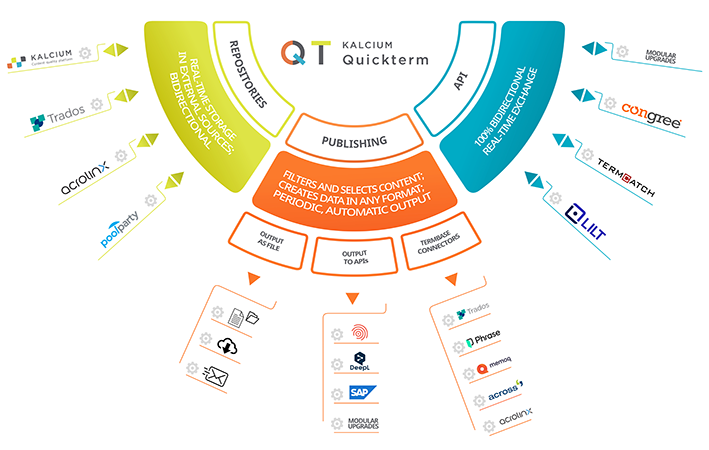The need to integrate your terminology into as many tools as possible, wherever content is created, is obvious to anyone who wants to ensure that terminology is used throughout the organization. Otherwise, you will not get the necessary buy-in from all content creators, from professional writers to translators, from marketers to software developers and engineers. They all want to have terminology at their fingertips, easily and quickly. But how do you integrate terminology into your business applications? Our blog post describes three ways how you can access, publish, and integrate terminology with our Kalcium platform.
The 3 ways to integrate terminology into business applications
- Live Repositories
- The Kalcium API
- Kalcium Publishing
- Conclusion: How to integrate terminology
- Would you like more information on how to integrate terminology into applications?
- Learn more about terminology here:

Live Repositories
With our special live repository technology, Kalcium can store terminology in an external repository in addition to our own terminology cache. For example, you can specify RWS MultiTerm Server as the external repository, or any of our other supported termbase technologies.
Every time you create a new entry in Kalcium Quickterm, this new entry gets written in real-time to the external repository, as well. The same works for changes or deletions, of course. Also, if you change something in the external repository, this change will be synchronized to Kalcium every time you update the termbase cache.
This means the repository technology offers the following advantages:
- It is real-time, meaning that any changes are immediately available to anyone who is connected to the external repositories, such as translators using Trados Studio and MultiTerm Server.
- It is bidirectional, meaning changes get written both from Kalcium to the external repository, as well as from the external repository to the termbase cache in Kalcium.
However, external repositories have certain specific restrictions, and these restrictions then in turn also apply to the termbase in Kalcium.
For example, not all repositories support:
- formatting in fields, let alone in terms
- nested fields (for example a field "Definition" with a sub-field "Source")
- Images uploaded as files in the termbase
PoolParty as a repository, for example, requires concepts to be linked either to a "top concept of the scheme" or a "broader" concept. So, if you already have a termbase and want to add PoolParty as a repository, you can map certain metadata as "top-level concepts of a scheme", for example, division or product range. But you will have to create the taxonomy relations in PoolParty at a later stage.
Acrolinx as a repository has a different approach to terms and concepts altogether, but these are managed appropriately by Kalcium Quickterm.
When choosing the repository approach, you have to weigh the advantages of bidirectional and real-time editing with the potential disadvantages of the specific repository.
Currently, we support the following repositories:
- RWS MultiTerm Server
- RWS Terminology (Trados Team / Accelerate / Enterprise)
- Acrolinx
- PoolParty
The Kalcium API
The entire Kalcium platform is "API first". That means everything you can do via the user interface, you can also do through external applications. This includes, of course, searching or editing terminology, or terminology verification. The most used features of the API are also contained in a separate Long-Term Support API, which will be maintained unchanged for backward compatibility.
Some of our technology partners use our API to integrate their applications with terminology hosted in Kalcium. These include Congree or Fodina (TermCatch). Several customers also build their own integrations into proprietary or corporate systems, such as SAP, Siemens NX, or other tools that can consume or use terminology, or where terminology plays a role in content creation.
These integrations are developed and maintained by our partners or by customers themselves. We provide extensive API documentation on Swagger, and we provide sample code on Nuget or GitHub.
Kalcium Publishing
An enormously powerful and adaptable tool for pushing terminology to other formats or systems is Kalcium Publishing. With this product, you can:
- Filter the exact content of the termbase you want to publish
- Select which fields to publish
- Select and define powerful transformations that create literally any target file structure
- Map language names or codes plus field names and field values between the two systems
Once you have configured the file structure you need for the target system, you can choose to output it to:
- File systems such as a network drive or (s)FTP server
- Email systems to create, for example, automated email outputs
- A target API
- A termbase connector
The last two offer additional powerful functionalities to automate data transfer:
In the target API configuration dialog, you can define any number of API calls to put through to the target system. So, for example, you can log in, select a termbase or target file store, delete the content of the target system, upload the new termbase, etc.
The termbase connector goes one step further and lets you log directly into one of the supported termbase connectors. Once you log in, you can select the target termbase. Kalcium Publishing will then read the structure of the target termbase and let you map the languages and fields of your termbase to those of the target termbase. That way, you can flexibly output your data into a termbase which potentially has a completely different structure.
In addition, the termbase connector technology will store the mappings of the entries and terms between your Kalcium termbase and the target one. That means that next time you run the Publishing task, Kalcium can add new entries, but also edit existing ones and even delete entries you have deleted in Kalcium.
As a last step in Kalcium Publishing, you can set up a schedule you want to use for automatically running these tasks in the background.
Some use cases:
- You want to automatically publish PDF or Excel glossaries once a week to a certain file location, or distribute them by e-mail
- You want to publish terminology to a generic API such as a machine translation system or SAP, EPLAN, or other corporate tools
- You want to automatically update termbases in supported CAT tools or also in Acrolinx
While the Publishing technology is not real-time and not bidirectional, as opposed to the live Repository approach, it is a lot more flexible when it comes to mapping different data structures and languages, and potentially even publishing one termbase to multiple target termbases in one or several external systems.
Supported Termbase Connectors for Kalcium Publishing currently are:
- RWS MultiTerm Server
- RWS Terminology (Trados Team / Accelerate / Enterprise)
- RWS WorldServer
- memoQ
- Phrase
- Acrolinx
- PoolParty
- Across / crossTerm
Conclusion: How to integrate terminology
In this blog post, we showed how you can ensure that everyone in your organization uses the right words consistently by integrating terminology into your business applications using our Kalcium platform. Because of its versatility, this platform enables integrations from translation or authoring software, ERP solutions to CAD systems, to name just a few. This allows you to make terminology available throughout your organization, which is an important step towards efficient terminology management and the correct use of the right words.
Would you like more information on how to integrate terminology into applications?
Learn more about terminology here:
- Webinar recording: Software That Grows With You Customized Terminology For Every Need
- White paper: 3 Steps to Optimal Terminology


